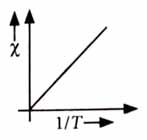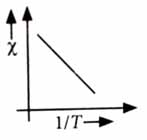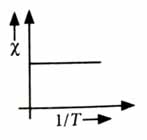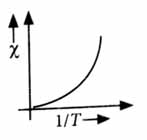Topic Question Set
Q 1
:
The incorrect relation for a diamagnetic material (all the symbols carry their usual meanings and is a small positive number) is [2024]
(4)
The relative magnetic permeability of diamagnetic material is slightly less than 1. So, the option is incorrect.
Q 2
:
Match List-I with List-II. [2024]
List-I (Material)
List-II (Susceptibility )
A.
Diamagnetic
I.
B.
Ferromagnetic
II.
C.
Paramagnetic
III.
D.
Non-magnetic
IV.
(a small positive number)
Choose the correct answer from the options given below:
A-II, B-III, C-IV, D-I
A-II, B-I, C-III, D-IV
A-III, B-II, C-I, D-IV
A-IV, B-III, C-II, D-I
(1)
For diamagnetic materials, magnetic susceptibility is less than zero i.e.,
So,
For ferromagnetic materials, magnetic susceptibility is large
So,
For paramagnetic materials, the value of magnetic susceptibility is small but positive
So,
For non-magnetic materials, magnetic susceptibility is zero.
So,
Hence, option (1) is correct
Q 3
:
The variation of susceptibility with absolute temperature for a paramagnetic material is represented as : [2023]
(1)
In accordance with Curie's Law,
vs graph will be straight line as shown in first graph.
Q 4
:
The magnetic susceptibility is negative for [2016]
ferromagnetic material only
paramagnetic and ferromagnetic materials
diamagnetic material only
paramagnetic material only
(3)
Magnetic susceptibility is negative for diamagnetic material only.





